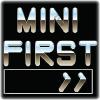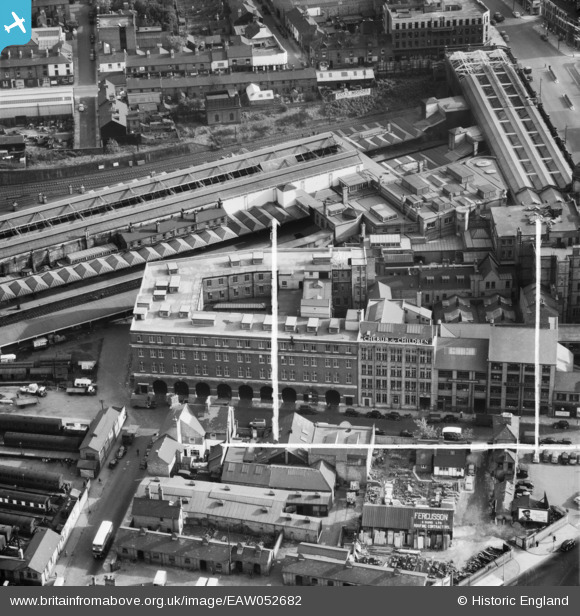  Ford Anglia E04A (1939–48)
The patriotically named first Ford Anglia, launched soon after Britain declared war on Germany in early September 1939,[3] and given the internal Ford model code of E04A, was a facelifted version of the Ford 7Y, a simple vehicle aimed at the cheap end of the market, with few features. Most were painted Ford black. Styling was typically late-1930s, with an upright radiator. There were standard and deluxe models, the latter having better instrumentation and, on pre-war models, running boards. Both front and rear suspensions used transverse leaf springs, and the brakes were mechanical.
The two-door Anglia is similar to the longer, four-door, E93A Ford Prefect. A bulge at the back enabled a spare wheel to be removed from its vertical outside stowage on the back of the car and stowed flat on the boot floor, which usefully increased luggage space. Some back seat leg room was sacrificed to the luggage space, being reduced from 43¾ inches in the Ford 7Y to 38½ inches in the Anglia |

Billy Turner |
Wednesday 24th of February 2016 11:55:56 PM |
 Fordson E83W van
The Fordson E83W, also sold later under the Thames brand, is a 10 cwt (half ton) light commercial vehicle that was built by Ford of Britain at the Ford Dagenham assembly plant (home of Fordson tractors) between 1938 and 1957. The van was sold in Australia as the Ten-Ten, and the E83W was available in various forms around much of the world as Britain strove to export after WW 2. In some countries, the 'cowl and chassis' only was imported and local bodies built.
The E83W was aimed at the small haulage, trade and merchant market, sectors in which it sold well. A 'Utilicon' estate wagon conversion was available in the UK. During and after World War II, many specialist variations such as mobile canteens, ice cream vans and even fire pumps were built on the E83W chassis. |

Billy Turner |
Wednesday 24th of February 2016 11:38:16 PM |
 1952 Austin A40 Somerset |

Billy Turner |
Wednesday 24th of February 2016 10:51:50 PM |
 1952 Karrier Bantam with British Railways livery. |

Billy Turner |
Wednesday 24th of February 2016 10:43:37 PM |
 Scammell Scarab (British Railways)
The Scammell Scarab is a British 3-wheeled tractor unit produced by the truck manufacturer Scammell between 1948 and 1967. Its name is commonly believed to be derived from the rounded bonnet that resembled the elytra (wing covers) of a Scarab beetle, but the name really comes from a more conventional source, Scammell's idea of the combination of an Arab horse (which the Mechanical Horse replaced in BR usage) and the word Scammell. Sca-rab = Scarab. The official Scammell Lorries Ltd advertisement film makes reference to this. It was extremely popular with British Railways and other companies which made deliveries within built-up areas. The Ministry of Defence also used the Scarab and trailers for predominantly internal transport on large military bases.
Behind the Scarab is a 1946 Morris Commercial CVF 13 also owned by British Railways. |

Billy Turner |
Wednesday 24th of February 2016 09:48:56 PM |
 1952-53 Morris LC4 Post Office van |

Billy Turner |
Wednesday 24th of February 2016 09:18:14 PM |
 Player's Please... |

Billy Turner |
Wednesday 24th of February 2016 08:52:42 PM |
 Royal Mail? |

Philip |
Wednesday 3rd of December 2014 01:47:55 AM |
 War damaged roof repair? |

Philip |
Wednesday 3rd of December 2014 01:46:42 AM |
 Someone's hung the washing out |

Philip |
Wednesday 3rd of December 2014 01:45:42 AM |
 Stables for railway horses |

Philip |
Wednesday 3rd of December 2014 01:35:21 AM |
 Locomotive water supply |

Philip |
Wednesday 3rd of December 2014 01:34:11 AM |
 Railway 3 wheel delivery vehicles which can detach from the load carrying part. |

Philip |
Wednesday 3rd of December 2014 01:30:05 AM |















![[EAW052682] Arthur Foister and Sons Ltd (Cherub Ltd) Factory on Campbell Street and London Road Railway Station, Leicester, 1953. This image was marked by Aerofilms Ltd for photo editing.](http://britainfromabove.org.uk/sites/all/libraries/aerofilms-images/public/100x100/EAW/052/EAW052682.jpg)
![[EAW052683] Arthur Foister and Sons Ltd (Cherub Ltd) Factory on Campbell Street and London Road Railway Station, Leicester, 1953. This image was marked by Aerofilms Ltd for photo editing.](http://britainfromabove.org.uk/sites/all/libraries/aerofilms-images/public/100x100/EAW/052/EAW052683.jpg)
![[EAW052687] Arthur Foister and Sons Ltd (Cherub Ltd) Factory on Campbell Street and London Road Railway Station, Leicester, 1953. This image was marked by Aerofilms Ltd for photo editing.](http://britainfromabove.org.uk/sites/all/libraries/aerofilms-images/public/100x100/EAW/052/EAW052687.jpg)
![[EAW052688] Arthur Foister and Sons Ltd (Cherub Ltd) Factory on Campbell Street and London Road Railway Station, Leicester, 1953. This image was marked by Aerofilms Ltd for photo editing.](http://britainfromabove.org.uk/sites/all/libraries/aerofilms-images/public/100x100/EAW/052/EAW052688.jpg)
![[EAW052684] Arthur Foister and Sons Ltd (Cherub Ltd) Factory on Campbell Street, Leicester, 1953. This image was marked by Aerofilms Ltd for photo editing.](http://britainfromabove.org.uk/sites/all/libraries/aerofilms-images/public/100x100/EAW/052/EAW052684.jpg)
![[EAW052686] Arthur Foister and Sons Ltd (Cherub Ltd) Factory on Campbell Street and London Road Railway Station, Leicester, 1953. This image was marked by Aerofilms Ltd for photo editing.](http://britainfromabove.org.uk/sites/all/libraries/aerofilms-images/public/100x100/EAW/052/EAW052686.jpg)
![[EPW014913] London Road Station and environs, Leicester, 1926. This image has been produced from a print.](http://britainfromabove.org.uk/sites/all/libraries/aerofilms-images/public/100x100/EPW/014/EPW014913.jpg)
![[EAW052685] Arthur Foister and Sons Ltd (Cherub Ltd) Factory on Campbell Street and London Road Railway Station, Leicester, 1953. This image was marked by Aerofilms Ltd for photo editing.](http://britainfromabove.org.uk/sites/all/libraries/aerofilms-images/public/100x100/EAW/052/EAW052685.jpg)
![[EAW052689] Arthur Foister and Sons Ltd (Cherub Ltd) Factory on Campbell Street and London Road Railway Station, Leicester, 1953. This image was marked by Aerofilms Ltd for photo editing.](http://britainfromabove.org.uk/sites/all/libraries/aerofilms-images/public/100x100/EAW/052/EAW052689.jpg)
![[EPW018434] The YMCA and environs, Leicester, 1927](http://britainfromabove.org.uk/sites/all/libraries/aerofilms-images/public/100x100/EPW/018/EPW018434.jpg)
![[EPW061212] The London Road Railway Station and environs, Leicester, 1939](http://britainfromabove.org.uk/sites/all/libraries/aerofilms-images/public/100x100/EPW/061/EPW061212.jpg)
![[EAW052678] Colton Street and Arthur Foister and Sons Ltd (Cherub Ltd) Factory on Charles Street, Leicester, 1953. This image was marked by Aerofilms Ltd for photo editing.](http://britainfromabove.org.uk/sites/all/libraries/aerofilms-images/public/100x100/EAW/052/EAW052678.jpg)
![[EAW052677] Rutland Street and St George's Church, Leicester, 1953. This image was marked by Aerofilms Ltd for photo editing.](http://britainfromabove.org.uk/sites/all/libraries/aerofilms-images/public/100x100/EAW/052/EAW052677.jpg)
![[EAW052679] Colton Street and Arthur Foister and Sons Ltd (Cherub Ltd) Factory on Charles Street, Leicester, 1953. This image was marked by Aerofilms Ltd for photo editing.](http://britainfromabove.org.uk/sites/all/libraries/aerofilms-images/public/100x100/EAW/052/EAW052679.jpg)
![[EAW052681] Arthur Foister and Sons Ltd (Cherub Ltd) Factory on Charles Street and St George's Church, Leicester, 1953. This image was marked by Aerofilms Ltd for photo editing.](http://britainfromabove.org.uk/sites/all/libraries/aerofilms-images/public/100x100/EAW/052/EAW052681.jpg)
![[EAW052675] Arthur Foister & Sons Ltd (Cherub Ltd) Factory on Charles Street, Leicester, 1953. This image was marked by Aerofilms Ltd for photo editing.](http://britainfromabove.org.uk/sites/all/libraries/aerofilms-images/public/100x100/EAW/052/EAW052675.jpg)
![[EAW052676] Arthur Foister & Sons Ltd (Cherub Ltd) Factory on Charles Street and St George's Church, Leicester, 1953. This image was marked by Aerofilms Ltd for photo editing.](http://britainfromabove.org.uk/sites/all/libraries/aerofilms-images/public/100x100/EAW/052/EAW052676.jpg)
![[EAW052674] Arthur Foister & Sons Ltd (Cherub Ltd) Factory on Charles Street, St George's Church and Rutland Street, Leicester, 1953. This image was marked by Aerofilms Ltd for photo editing.](http://britainfromabove.org.uk/sites/all/libraries/aerofilms-images/public/100x100/EAW/052/EAW052674.jpg)
![[EAW052680] Arthur Foister and Sons Ltd (Cherub Ltd) Factory on Charles Street, Leicester, 1953. This image was marked by Aerofilms Ltd for photo editing.](http://britainfromabove.org.uk/sites/all/libraries/aerofilms-images/public/100x100/EAW/052/EAW052680.jpg)






